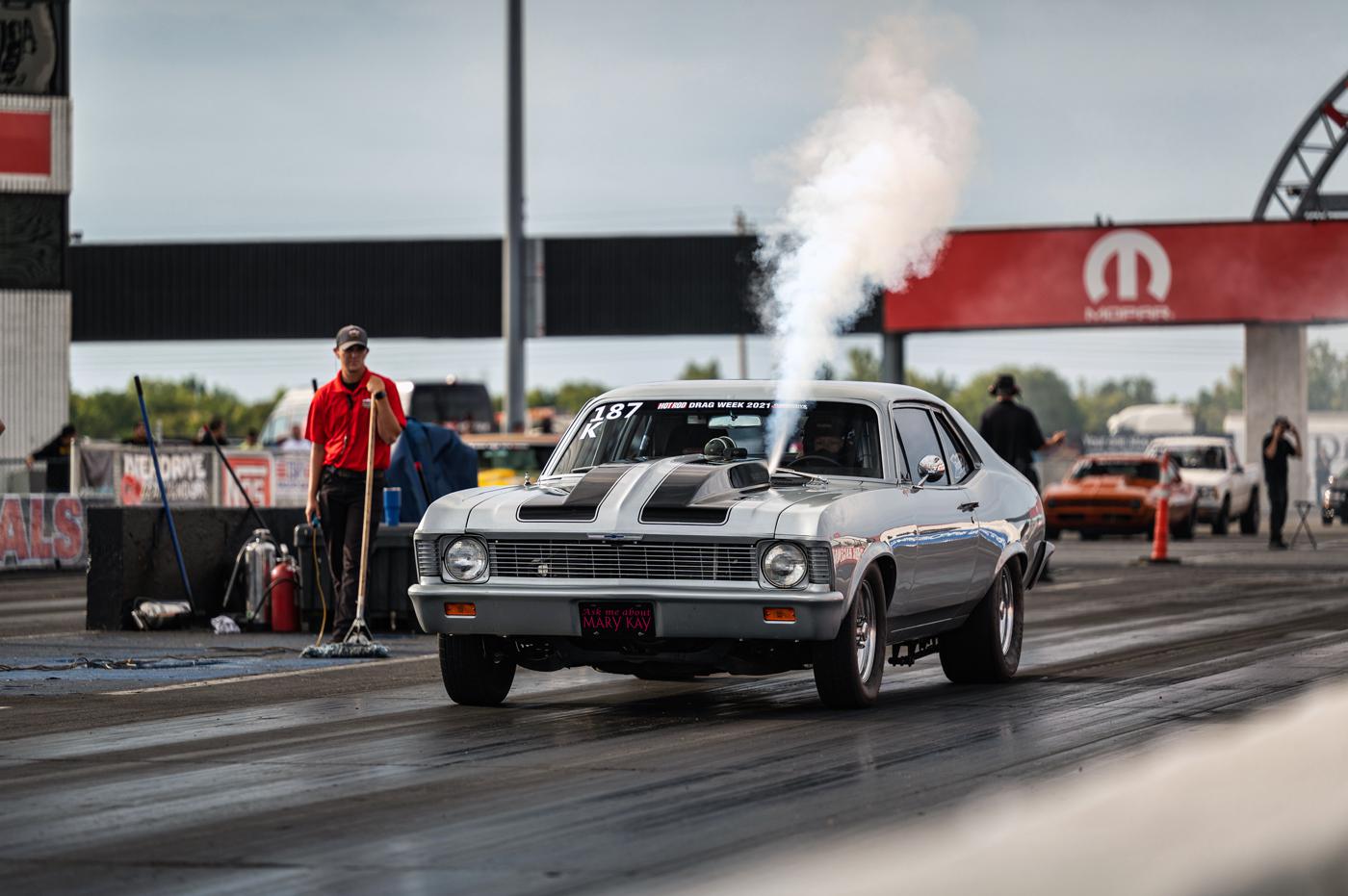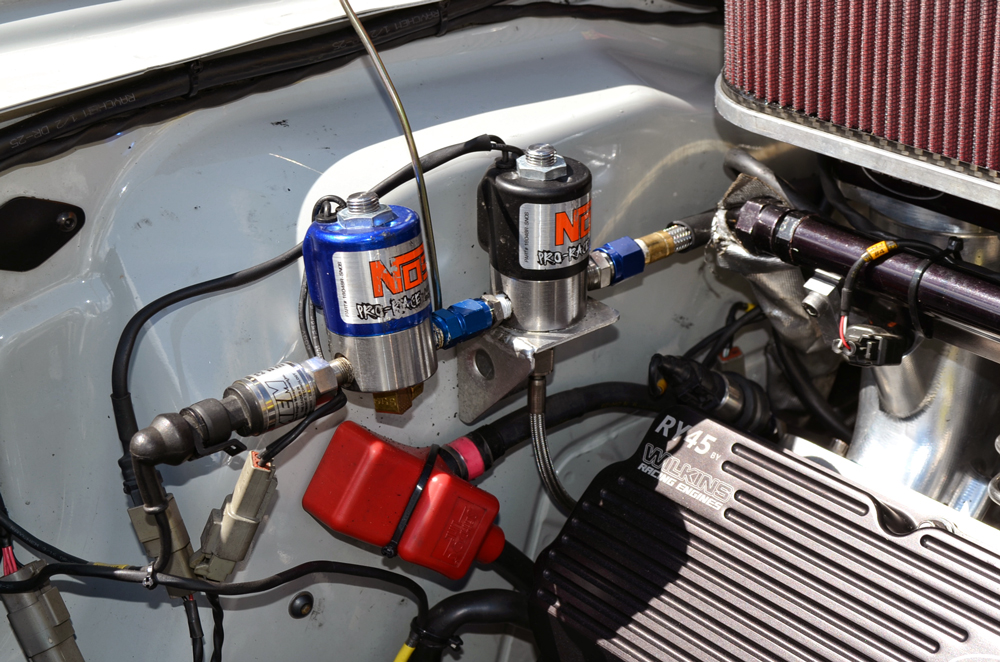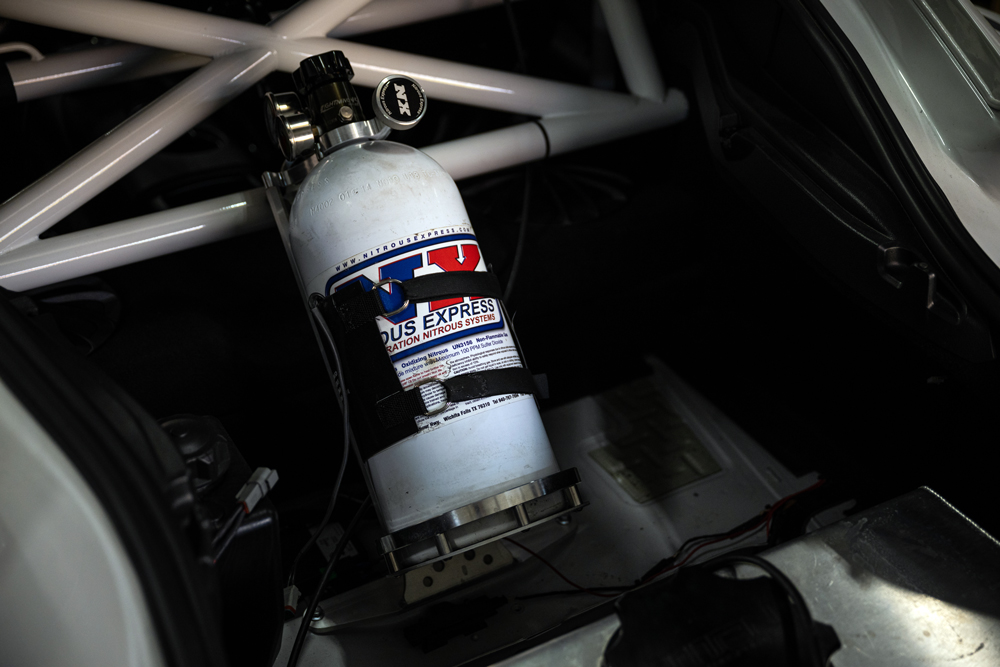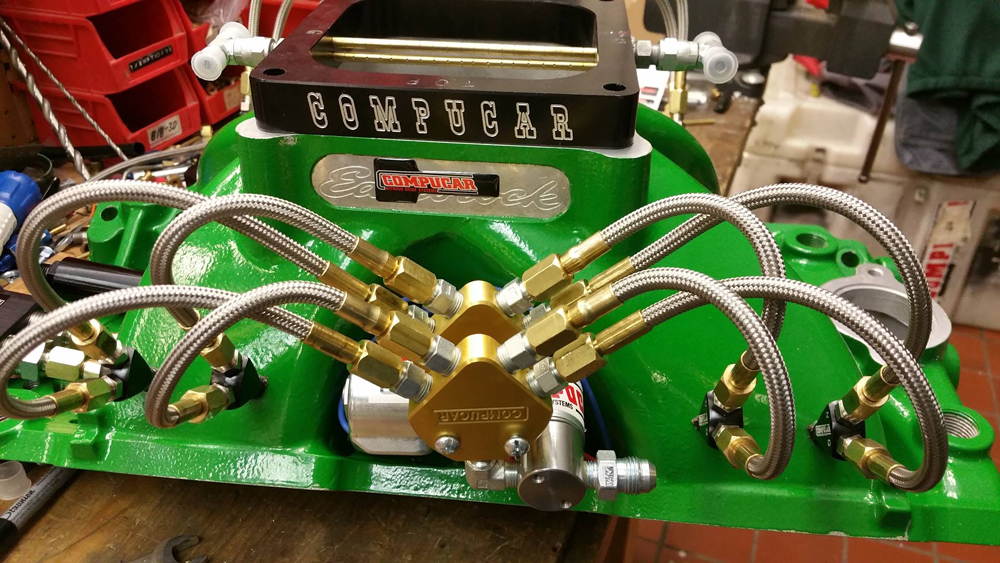Spray Plan

While nitrous systems are relatively easy to install and use, improper setup and maintenance can have serious consequences. Here, experts provide insight into some of the most common mistakes engine builders and racers make with their nitrous combinations, along with best practices that can help avoid major headaches down the road.
For more than 60 years, nitrous oxide has been one of the best bang-for-the-buck methods to add more power to an engine. But the trail of fried engine components that has been left in its wake also illustrates a path that can be fraught with peril. Fortunately, shared knowledge and experience have helped engine builders and racers zero in on increasingly dependable setups over the years. As competitors continue to push the envelope and more sophisticated technologies are introduced into the mix, today’s nitrous setups are more efficient and reliable than ever before.
“One of the biggest changes I’ve seen in recent years is the adoption of EFI and dry nitrous setups,” said Doug Flynn of Holley Performance Products, Bowling Green, Kentucky. “Ten years ago, people were saying that you couldn’t do that, but now nearly all of the Pro Nitrous cars are running fuel injection. Tied to that is the more widespread use of data acquisition. A lot of racers are running eight wideband 02 sensors to monitor the air/fuel ratio in the cylinders to tune each of them individually. That allows things to be safer, and that in turn allows them to run more nitrous.”

Cody Sprague of Nitrous Express in Wichita Falls, Texas, said that the latest progressive controllers can provide a level of adjustment and automation that was unheard of just a few years ago. “Controllers like our Maximizer 5 have the capability to data log and set up numerous safety features to keep a vehicle making great power safely. This controller monitors throttle percentage, engine rpm, nitrous PSI, boost or pan vacuum, as well as other user-defined sensors to ensure that the engine is in the correct state to accept nitrous. If it detects any condition that is outside the safe range, the controller will shut down or pull back nitrous flow to protect the engine from any damage.”
Yet despite these advances, nitrous still has the potential to trip up newcomers and seasoned veterans alike, and the consequences can still be disastrous. “It’s the easiest way to get horsepower, but there’s a lot of bad information floating around out there,” warned Ernie Wrenn of Compucar Nitrous Systems, North Augusta, South Carolina. “If the guy next to you has blown his motor up, you probably don’t want his tuning advice.”

Dave Vasser of Nitrous Outlet in Waco, Texas, said that bad habits can be tough to break. “A common struggle for us is the guy who believes, ‘I’ve been using nitrous for 30 years, you can’t tell me to do it this other way.’ We’ve spent a lot of time telling customers that they’re going to blow their car up. It does us no good to make that one-time sale and lose a customer for life because they didn’t listen to us and then ran into problems later.”
With that in mind, let’s take a closer look at where things tend to go wrong with nitrous combinations in racing applications, and what can be done to ensure that an engine lives to spray another day.
Setup and Tuning
Vasser said many folks make the false assumption that the installation guidelines for nitrous oxide systems haven’t really changed over the years. “Back in the day, people were told to take everything to a chassis ground. But today with things like high-voltage fuel pumps, modern ignition systems, and the other electronics that are often involved, there’s no such thing as a clean chassis ground anymore. It has to go directly to the battery because all of those electronics transfer noise, and nitrous controllers are very susceptible to that noise. The battery acts like a noise filter, and it’ll keep that noise from traveling back up to the controller and causing it to malfunction.”
Another area where problems tend to crop up is with solenoid fitting installation, according to Sprague. “We send filtered fittings in all of our nitrous systems to protect the nitrous solenoids and jets from debris,” he said. “If this is done wrong, a racer could end up with leaking solenoids or clogged jets, and that’s going to have an effect on performance. Avoiding that is really just a matter of following the installation guidelines in the instructions.”
Flynn said that in nitrous-heavy combinations, racers often make the mistake of trying to run too much timing in hopes of extracting every last bit of performance on the table. While that aim is certainly understandable, it often does more harm than good.
“A lot of people are running timing well into the single digits—five, four, or even three degrees,” Flynn explained. “And I think some people have this perception that this can’t be right and that they’re losing too much power as a result, so they’ll add more and hurt the engine. More often than not, it didn’t need that additional timing in the first place because they’re not leaving power on the table. Some cylinders make more cylinder pressure, and you need to take more timing out of those, otherwise you run the risk of all sorts of problems. That can lead to detonation, loss of ring seal, and then if you get oil inside the combustion chamber, you can end up with a melted piston.”
He suggested that the best approach is to start off conservatively and dial it up slowly. “I always tell people that they can add it back in, but they can’t take it back out after the engine is burned up. Start lower than you think you need to and sneak up on it,” Flynn advised. “Guess too high the first time around and there might not be a second chance.”
With a nitrous motor, “reading the spark plugs is probably the most effective tool to determine if you’re on the right track,” Flynn added. “Look at the ground strap and the coloration of the threads, and also look at the porcelain for a read on the air/fuel ratio. There’s a science to it.”
Wrenn said that tuners also need to pay close attention to jet spread. “Different manufacturers use different jet spreads because some of them use higher fuel pressure than others,” he explained. “The idea there is to get better fuel flow through the nozzle, but with nitrous spraying at 950 psi, when it comes out of the end of that nozzle, there is actually a vacuum going up through the fuel side. If you ignore how that vacuum is affecting the mixture, you can get into a situation where the fuel-to-nitrous ratio is unstable. You basically need a 5:1 ratio. Get away from that and you’re not going to be able to tune accurately. You have a rich motor to begin with, and now you’re trying to lean the nitrous system down to make up for it, and you could end up lifting rings.

“Very few motors are ever hurt because of lean conditions; most of them are hurt because they’re too rich,” Wrenn added. “Spraying 950 psi creates a vacuum behind that pressure, and that vacuum makes the carburetor draw more air and makes the jets run richer. So consider the cubic inches of the motor, the compression ratio, and what carburetor and intake the engine is running. That’s going to tell us how much vacuum it’s drawing, and then you can determine which jets are right for the combination. You’ve got to get that right first.”
A general lack of understanding about how fuel pressure affects the tune in a wet system is a prevalent issue among racers running nitrous combinations, Flynn said, but he also noted that it’s a problem that’s entirely avoidable today. “When running a wet system, you need to flow the fuel system to set the pressure because that has a huge impact on the tuning,” he explained. “It’s critical. A nitrous tune is based on a specific fuel pressure within a quarter of a PSI. If that’s far off from what the fuel pressure actually is, the correct tune is going to be completely different. So it could end up too rich, or too lean, and that could damage the engine. That’s one of the nice things about dry nitrous systems: You don’t have to worry about any of that because there’s nothing there to put through the injectors.”
Keeping Up on the Upkeep
When it comes to maintenance issues, Sprague pointed to nitrous filters—or the potential lack thereof. “It’s a mistake to think that removing the nitrous filter on the inlet fittings on the solenoid will provide more flow.” A tune that starts to go rich is a good indication that the filter is clogged and needs to be cleaned.
“It’s going to be down on performance because it’s restricting the nitrous flow, but the fuel flow is still there,” Vasser said. “Racers will often pull fuel out over and over again before realizing that there’s actually something causing a blockage. But not running a nitrous filter can lead to much bigger problems. Without a filter, that debris would be able to get underneath the solenoid and could potentially hang it open. If it leaks, what tends to happen is that it still lets nitrous by even after the system is turned off, and that’s going to cause a backfire.”
Even with a regularly maintained filter in the system, it’s important to routinely check the pistons and solenoids. “They tend to mushroom over time, and you can end up with a leak through the piston, or the piston will actually start to restrict flow as it mushrooms out. At that point you’re losing performance,” Flynn said. “One of the leading causes of that damage is leaving pressure in the system. Closing the bottle and purging the pressure out after a run is the best thing to prevent that.”
Improperly gapped spark plugs can also lead to problems. “A lot of racers take the spark plugs out of the box and just screw them into the motor, but the gap needs to be set correctly,” Wrenn said. “The gaps are set from the factory for a normal street car, not a racing application. They could be 40 thousandths, and they need to be between 22 and 25 thousandths. We have to close up that gap so the kernel will be small enough to get good ignition under high cylinder pressures. If the gap is too big, you have the potential to drop a cylinder going down the track, and that’s a good way to hydraulic a cylinder. It’s also important to have the right ignition system for the job. An MSD 6AL is great for a street car or light competition, but it’s probably not going to cut it in a purpose-built racing application.”
When it comes to safety, Vasser said that bottle certification is something that everyone running nitrous oxide should take seriously. “Aluminum bottles are supposed to be recertified every five years, and carbon bottles are supposed to be recertified every three years,” he stated. “If someone comes to us with a bottle that’s out of certification, we won’t fill it. It’s a vessel that’s pressurized to 1,000 PSI. If that bottle explodes, it could kill you. The guys who you see at the track using torches to heat up bottles are really putting themselves in jeopardy. In cars where the bottle is mounted under glass—like in a hatchback—sunlight can be magnified through the glass, and bottles that have been continuously heated over and over again like that can develop weak spots in the aluminum. It costs $25 to have a bottle recertified, and I’d consider that money well spent.”
Sources
Compucar Nitrous Systems
facebook.com/compucar.nitrous/
Holley Performance Products
holley.com
Nitrous Express
nitrousexpress.com
Nitrous Outlet
nitrousoutlet.com
 MEMBERSHIP LOGIN
MEMBERSHIP LOGIN JOIN PRI
JOIN PRI


